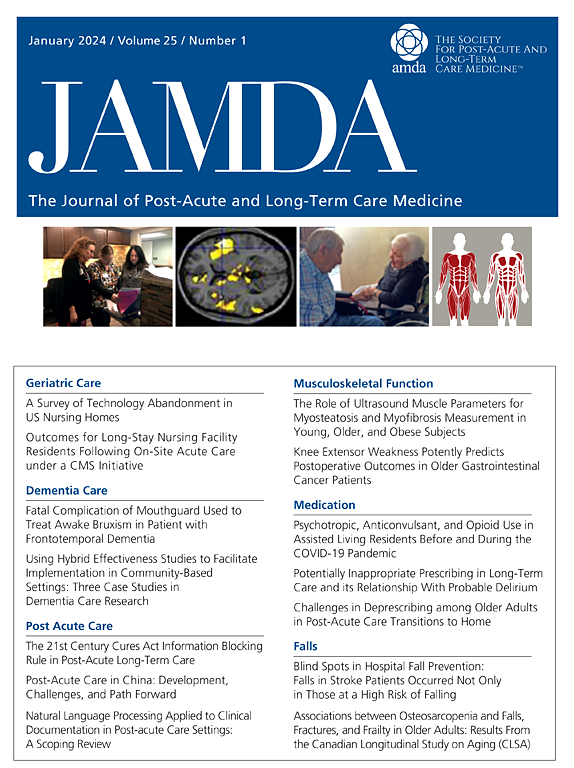日本有护理需求的老年人的住房改造和入住长期护理机构的情况。
IF 3.8
2区 医学
Q2 GERIATRICS & GERONTOLOGY
Journal of the American Medical Directors Association
Pub Date : 2024-09-28
DOI:10.1016/j.jamda.2024.105290
引用次数: 0
摘要
目的:对住房进行改造可能会降低有护理需求的老年人入住长期护理机构(LTCF)的风险,从而有助于实现居家养老,但这种关联性尚不明确。我们研究了有护理需求的老年人住房改造与入住长期护理机构之间的关系:设计:回顾性队列研究,使用日本一个市镇的数据:环境/参与者:2014年4月至2016年3月期间在公共长期护理保险制度下新被证明有护理需求的年龄≥65岁的成年人:研究暴露是在获得认证后的 2 年内实施由保险承保的住房改造(最高承保费用:20 万英镑)。在此基础上,参与者被分配到未实施组(无住房改造)、低于最高成本组(低于最高成本的住房改造)或最高成本组(最高成本的住房改造)。在对各种风险因素进行调整后,采用 Fine-Gray subdistribution hazards 模型来分析暴露组别与新入住 LTCF 之间的关联。死亡被视为竞争风险,参与者的随访一直持续到2022年3月:在 4610 名参与者中,有 1261 人(27.3%)进行了住房改造。其中,943 人(74.8%)属于次高成本组,318 人(25.2%)属于高成本组。在随访期间(中位数:51个月),未实施组的长者入住长者护理院的发生率为3.9/1000人月,次高成本组为3.8/1000人月,最高成本组为2.8/1000人月。经调整后,次高成本组入住 LTCF(参考:未实施)的危险比为 0.90(95% CI:0.75-1.08),最高成本组为 0.67(0.49-0.93):住房改造可以帮助有护理需求的老年人实现居家养老。医疗保健专业人员和政策制定者应考虑住房环境的适宜性,以降低入住养老院的风险。本文章由计算机程序翻译,如有差异,请以英文原文为准。
Housing Adaptations and Long-Term Care Facility Admissions among Older Adults with Care Needs in Japan
Objectives
Housing adaptations may contribute to aging in place for older adults with care needs by reducing the risk of long-term care facility (LTCF) admissions, but this association remains unclear. We examined the association between housing adaptations and LTCF admissions among older adults with care needs.
Design
Retrospective cohort study using data from a Japanese municipality.
Setting/Participants
Adults aged ≥65 years who were newly certified with care needs under the public long-term care insurance system between April 2014 and March 2016.
Methods
The study exposure was the implementation of insurance-covered housing adaptations (maximum covered cost: ¥200,000) during the 2 years after certification. Based on this exposure, participants were assigned to a non-implementation group (no housing adaptations), sub-maximum cost group (housing adaptations below the maximum cost), or maximum cost group (housing adaptations at the maximum cost). A Fine-Gray subdistribution hazards model was used to analyze the associations between the exposure groups and new LTCF admissions after adjusting for various risk factors. Death was regarded as a competing risk, and participants were followed until March 2022.
Results
Among 4610 participants, 1261 (27.3%) had implemented housing adaptations. Among these, 943 (74.8%) were in the sub-maximum cost group and 318 (25.2%) were in the maximum cost group. During the follow-up period (median: 51 months), the incidence of LTCF admission was 3.9/1000 person-months in the non-implementation group, 3.8/1000 person-months in the sub-maximum cost group, and 2.8/1000 person-months in the maximum cost group. The adjusted subdistribution hazard ratio of LTCF admission (reference: non-implementation) was 0.90 (95% CI: 0.75–1.08) for the sub-maximum cost group and 0.67 (0.49–0.93) for the maximum cost group.
Conclusions and Implications
Housing adaptations can support aging in place for older adults with care needs. Health care professionals and policymakers should consider the suitability of housing environments to reduce the risk of institutionalization.
求助全文
通过发布文献求助,成功后即可免费获取论文全文。
去求助
来源期刊
CiteScore
11.10
自引率
6.60%
发文量
472
审稿时长
44 days
期刊介绍:
JAMDA, the official journal of AMDA - The Society for Post-Acute and Long-Term Care Medicine, is a leading peer-reviewed publication that offers practical information and research geared towards healthcare professionals in the post-acute and long-term care fields. It is also a valuable resource for policy-makers, organizational leaders, educators, and advocates.
The journal provides essential information for various healthcare professionals such as medical directors, attending physicians, nurses, consultant pharmacists, geriatric psychiatrists, nurse practitioners, physician assistants, physical and occupational therapists, social workers, and others involved in providing, overseeing, and promoting quality

 求助内容:
求助内容: 应助结果提醒方式:
应助结果提醒方式:


